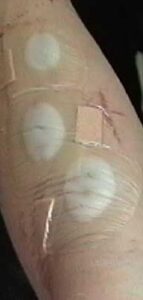SELF-HARM. KIDS CUTTING ON
YOU TUBE: ALARMING,
DANGEROUS & WIDE-SPREAD
If you are young person who is cutting yourself, you might want to read this.
If you are a parent whose child is harming herself, you definitley want to read this.
The Toronto Star published a piece (Feb.22, 2011) by Nancy J. White, discussing a study in the Journal, Pediatrics, on the prevalence of self-harm videos on You Tube.
The situation has not improved.
Teenagers and young adults are the prime focus of the study—since they are the prime self-abusers.
They don’t know themselves and what they do know they don’t much like.
As bad as having videos of self–abuse on You Tube is (and it’s bad—there are more than 400 self-abuse sites on the Internet apparently—the researchers looked at about 100 of them) the real problem is the fact that so many young people harm themselves in the first place.
WHAT KIND OF SELF-HARM?
 Cutting
Cutting- Burning
- Lacerating
- Embedding objects under the skin
Those are the most frequent kinds of self-harm.
Cutting is the most popular (the cuts are mainly on the arms or wrists). But there are other ways to accomplish the same goal which is to produce wounds which are moderately serious, often produce blood and leave physical scars.
The videos are graphic and include
- blood
- burns
- slash marks
- razor cuts
- knife cuts
- glass cuts
- pictures of parts of the body with sharp objects stuck inside
- pictures of semi-bald kids who have ripped hair out of their heads.
HOW MANY PEOPLE DO THIS?
Estimates are that between 14-24% of young people hurt themselves in some way. One out of four young people! It’s frightening.
Several years ago at the prestigious universities Princeton and Cornell, researchers discovered that as many as one in five of their students were self-abusers. The universities were shocked and queried other educational institutions in the U.S. to determine whether the incidents at their schools might have been anomalies.
The administrators thought the practice might have been promoted by the ferocious intellectual competition at these schools and was therefore restricted to universities and colleges of extremely high repute.
No.
They discovered that the same practices were occurring in roughly the same percentages all over the US at all kinds of colleges. You can bet it’s true of Canada as well; at least it is in my experience teaching at a college in Toronto.
WHAT THE HELL’S WRONG WITH THESE PEOPLE?
They’re in big psychological trouble.
They do it to cope with emotional or psychological pain in a physical way. One girl I spoke with said she cut herself because it “was the only way she knew to tell people about how she was hurting inside without actually talking to someone.” She said she didn’t have anyone she could talk to about her real (emotional) problems. I saw and spoke with dozens of students like her at the college where I taught.
WHAT IS SELF-HARM?
Self-injury or self-harm is defined as any behavior done to oneself that yields damage and is not intended to be suicidal, says Stephen Lewis, assistant professor of psychology at the University of Guelph in Ontario, the lead author of the study.
(We’re not talking suicide here but that’s a whole other unhappy topic regarding young people both in and out of school.)
And we’re not talking about the usual kinds of problems (or symptoms of problems) that young people have with
- alcohol
- drugs
- sex
- gambling
- etc.
And we’re certainly not talking about the normal crap that goes on:
- sleeping too much
- missing classes
- failing to do academic work
- using MSN too much
- partying too much
- etc.
These kids are way past those problems. Their problems involve the self.
A SERIOUS SELF-ESTEEM PROBLEM
But if you have a serious self-image problem and are hurting inside and you’re also broke, self-harm is an increasingly common respose.
Drinking and drugs cost money but self-harm is free and there are no age restrictions so it is a self-punishment of choice for these kids.
However, we’re also not talking (explicitly, anyway) about the loneliness, depression and feelings of loss or abandonment that these young people are suffering. They have almost zero self-esteem.
In fact, this problem is largely unknown to the general population and its existence, and how to cope with it, is only now (and often reluctantly, and mainly ineffectually) being addressed by some colleges and universities where many of these self-harming victims are found.
Parents often aren’t aware that their child is harming herself, and if they are, they generally don’t want to talk about it either because of fear of criticism by others (they might be accused of poor parenting), or a belief that it isn’t serious, or “it’s just a “phase,” or because of some other fanciful or inadequate response.
The young people are harming themselves because
- they don’t like themselves
- they think they are worthless
- they have low self-esteem
- they feel alone
- they lack confidence because they seem to have no one to talk with, confide in, help them.
They do it to bear witness physically to their mental, spiritual, psychological or emotional pain. They do it so that somebody will notice them. They don’t really know why they do it but it is a cry for help.
They do it because they can find no one to speak to about their inner pain.
I hope they find a place here where someone will try to understand them.
Thank you for reading this.
Be vigilant regarding these young people. They need your experience and counsel.
At Dropout To Dean’s List, we’ll report on this and other topics related to the self.
For more information about the Self and your own life, please register below. You can immediately download a gift from me —
WHY DO SO MANY STUDENTS DROP OUT AND WHAT CAN WE DO ABOUT IT?
Then, you’ll receive another gift, a paper —
HOW COLLEGES LIE ABOUT CLASS TIME.
It’s adapted from my book Who Are You And What Are You Doing Here? The way to know yourself and get what you want.
NEXT: SELF-HARM (Part 2): THE SCOPE OF THE PROBLEM.
For more information on this and other subjects about our children and what’s going on in education today,
Register for DDL right here!

REGISTER HERE:
Dropout To Dean’s List






